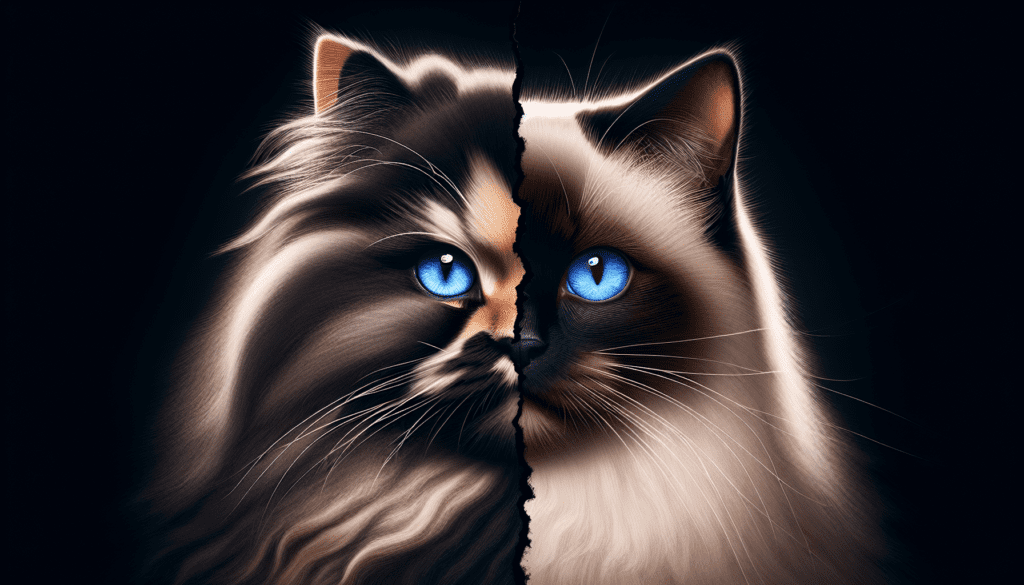Imagine the exquisite beauty and unique traits that emerge when two majestic cat breeds merge their distinct characteristics. In the world of feline fascination, curiosity surrounds a new breed that arose from the captivating union of Persians and Siamese cats. How did this fusion of cultures, if you will, give birth to a fascinating breed that showcases the best of both lineages? Delve into this intriguing story of feline genetics as we unveil the captivating mystery behind the breed resulting from the enchanting crossbreeding of Persians with Siamese cats.

History of the Crossbreed
Crossbreeds, also known as mixed or hybrid breeds, are the result of intentionally breeding two different purebred cats to create a new breed with unique characteristics. The crossbreed of Persian and Siamese cats emerged from the desire to combine the elegant beauty of the Persian with the striking color points of the Siamese. Let’s delve into the fascinating history of this enchanting crossbreed.
Origin of Persian Cats
The Persian cat is one of the oldest and most beloved cat breeds in the world. Its origins trace back to ancient Persia (modern-day Iran) and were brought to Europe in the 17th century by Italian traders. Renowned for their luxurious and long coats, expressive round faces, and gentle disposition, Persians quickly gained popularity among cat enthusiasts.
Origin of Siamese Cats
The Siamese cat originated from the ancient kingdom of Siam (now Thailand) and captured the attention of the Western world in the mid-19th century when they were introduced to England. What sets Siamese cats apart are their striking color points, which are darker on their extremities, such as the ears, face, paws, and tail. Their piercing blue eyes and sleek bodies further contribute to their undeniable allure.
Crossbreeding the Persians with Siamese
The crossbreeding of Persians with Siamese cats was a deliberate attempt to combine the best features of both breeds. Breeders sought to merge the Persian’s exquisite appearance, calm temperament, and flowing coat with the Siamese’s distinctive color patterns and lithe physique. Through careful selective breeding, the crossbreed brought forth a unique feline with an extraordinary blend of characteristics.
Characteristics of the Crossbreed
The crossbreed of Persian and Siamese cats inherits a mesmerizing combination of physical appearance, coat color and patterns, as well as temperament and personality traits.
Physical Appearance
The crossbreed showcases a harmonious fusion of features from its parent breeds. These cats often possess the Persian’s rounded head, short muzzle, and expressive eyes while adopting the Siamese’s long and slender body structure. Their tails tend to be more plumed and bushy than the slender tails of Siamese cats.
Coat Color and Patterns
One of the most striking characteristics of the crossbreed is its coat color and pattern variations. These cats can exhibit a wide range of color points, including seal, chocolate, blue, and lilac. Their body color can range from pure white to cream, and their coats may showcase patterns such as the classic point, mitted, or bi-color.
Temperament and Personality
The crossbreed inherits a delightful mix of personality traits from both the Persian and Siamese breeds. Generally, they tend to be affectionate, gentle, and laid-back like their Persian ancestors. However, they also possess some of the siamese cats’ traits, such as playfulness, vocalization, and sociability. They are known to be intelligent and adaptable, making them wonderful companions for individuals and families alike.
Naming the Crossbreed
As with any new breed, the naming process for the crossbreed of Persian and Siamese cats went through various stages, including early controversies and eventual recognition.
Early Naming Controversy
When the crossbreed first emerged, it sparked controversy among cat enthusiasts, breeders, and cat associations. Some argued that the crossbreed should be recognized as a new breed with its own distinct name, while others believed it should be considered a variant or a hybrid of the Persian and Siamese breeds. This disagreement over naming conventions led to debates within the cat fancy community.
Official Recognition of the Breed
After years of discussions and evaluations, several cat associations recognized the crossbreed as a distinct breed. These associations acknowledged its unique characteristics and granted official recognition, allowing breeders to further develop and promote the breed. This recognition also ensured that the breed would be eligible for cat shows and competitions.
Current Accepted Breed Name
The crossbreed of Persian and Siamese cats is now commonly known as the Himalayan. The name “Himalayan” was chosen due to the breed’s striking color points and the resemblance they bear to the snow-capped peaks of the Himalayan Mountains. This name reflects the breed’s elegance, beauty, and unique combination of Persian and Siamese traits.
Breed Standards and Recognition
The Himalayan breed is governed by various cat associations, which establish and maintain the breed standards and guidelines. These standards encompass the physical attributes and qualities expected of Himalayans and determine their eligibility for show rings.
Governing Cat Associations
Several prominent cat associations, including The International Cat Association (TICA), the Cat Fanciers’ Association (CFA), and the World Cat Federation (WCF), recognize and validate the Himalayan breed. These associations play a crucial role in regulating and promoting the breed, ensuring that breeders adhere to breeding standards and ethical practices.
Physical Attributes and Standards
The breed standards for the Himalayan outline specific physical attributes that define the breed. These include the cat’s overall body shape, head and facial structure, eye color, and coat length, texture, and color points. The standards are carefully defined to maintain the distinctive characteristics that distinguish the Himalayan breed.
Show Rings Eligibility
Thanks to its recognition as a distinct breed, the Himalayan is eligible to participate in cat shows and competitions organized by various cat associations worldwide. Himalayans are judged based on how well they conform to the breed standards, including factors such as coat quality, eye color, body structure, and overall presentation. Winning accolades in cat shows helps promote the breed’s popularity and showcases breeders’ efforts to enhance its qualities.

Health Considerations
As with any breed, the Himalayan cat may be prone to certain inherited health issues and common health problems. However, with proper care and maintenance, these cats can lead healthy and fulfilling lives.
Inherited Health Issues
Due to generations of selective breeding, Himalayans may be susceptible to certain inherited health issues. Polycystic kidney disease (PKD) is one such condition that can be prevalent in some Himalayans. Responsible breeders conduct genetic testing to identify cats carrying the PKD gene to minimize the risk of passing it on to future generations.
Common Health Problems
Additionally, Himalayans may experience health problems common to cats with flat faces (brachycephalic breeds). Issues such as breathing difficulties, dental problems, and eye conditions, including tear duct abnormalities and progressive retinal atrophy (PRA), can occur. Regular veterinary check-ups and proper grooming are essential to maintaining their overall health and preventing potential complications.
Care and Maintenance
Proper care and maintenance are crucial for the well-being of Himalayans. Due to their long and dense coats, daily grooming is necessary to prevent matting and hairballs. Regular dental care, such as teeth brushing, can help prevent dental issues. Providing a balanced diet, regular exercise, and a stimulating environment are also vital in ensuring their overall health and happiness.
Popularity and Adoption
The crossbreed of Persian and Siamese cats, the Himalayan, has gained popularity among cat lovers worldwide. Let’s explore the rising popularity, adoption trends, and considerations regarding the pricing and cost of acquiring a Himalayan.
Rising Popularity
The Himalayan breed’s striking appearance, affectionate nature, and unique blend of characteristics have contributed to its rising popularity. Cat enthusiasts are drawn to their enchanting beauty, calm temperament, and playful personalities. The breed’s rising popularity is evident in the increasing number of breeders specializing in Himalayans and the growing presence of these cats in households globally.
Adoption and Availability
If you’re considering adopting a Himalayan, you have several options available. Reputable breeders specializing in Himalayans can provide you with a wide selection of kittens, ensuring the cat’s health, bloodline, and adherence to breed standards. Additionally, rescue organizations and animal shelters may occasionally have Himalayans available for adoption, giving you the opportunity to provide a loving home for a cat in need.
Pricing and Cost
The cost of acquiring a Himalayan can vary depending on factors such as the breeder, bloodline, pedigree, and the kitten’s overall quality. On average, Himalayans from reputable breeders can range from several hundred to a few thousand dollars. It’s essential to consider the initial cost of purchasing a Himalayan, as well as ongoing expenses such as veterinary care, grooming supplies, and quality cat food.
Famous Crossbreeds
The crossbreed of Persian and Siamese cats, the Himalayan, has garnered attention and affection from many well-known individuals, celebrities, as well as the media and entertainment industry.
Well-known Individuals
Many famous individuals have owned Himalayans, further elevating the breed’s reputation and popularity. From esteemed authors like Ernest Hemingway to famous actors and actresses like Audrey Hepburn, Himalayan cats have charmed and found their way into the hearts of prominent figures throughout history.
Celebrity Ownership
Celebrities often find solace, companionship, and elegance in the company of Himalayan cats. Stars like Taylor Swift, Mariah Carey, and Karl Lagerfeld have been known to keep Himalayans as loyal and beloved pets, solidifying the breed’s presence in the realm of the rich and famous.
Breeds in Media and Entertainment
Himalayan cats have also made appearances in various forms of media and entertainment. These charismatic felines have charmed audiences through movies, television shows, advertisements, and even as characters in literature. Their stunning beauty and distinct personalities have made them an appealing choice for showcasing the elegance and allure of cats.
Breeding and Genetics
Breeding Himalayan cats involves careful selection, consideration of genetic traits, and an understanding of relevant Punnett squares to predict the outcomes of specific pairings.
Breeding Methods
Breeding Himalayan cats requires matching individuals that possess desirable traits while taking into account potential hereditary health concerns. Breeders meticulously select parent cats based on their breed standards, conformation, temperament, and genetic health to improve future generations. Breeding programs aim to refine and enhance the breed while ensuring the well-being of the cats involved.
Genetic Traits
Himalayans inherit various genetic traits from their Persian and Siamese ancestors. These traits include coat color, coat length, eye color, body structure, and temperament. Breeders selectively mate cats to encourage the passing on of desired traits and minimize the likelihood of inherited health issues.
Relevant Punnett Squares
Understanding relevant Punnett squares, a visual tool used in genetics to predict the inheritance of specific traits, plays a crucial role in breeding Himalayan cats. These squares help breeders assess the probability of offspring inheriting certain coat colors, patterns, and other hereditary characteristics.
Crossbreeds vs Purebred
Crossbreeds, such as the Himalayan, offer several advantages and unique qualities when compared to their purebred counterparts. It’s essential to consider these factors when deciding on the perfect feline companion.
Advantages of Crossbreeds
Crossbreeds, like the Himalayan, often possess a blend of characteristics from both parent breeds. This diversity can result in a more robust genetic pool, potentially reducing the risk of inheriting certain genetic health issues that can be more common in purebred cats. Crossbreeds may also exhibit a unique combination of traits, such as the Himalayan’s elegant appearance fused with the Siamese’s distinctive color points.
Comparison with Persian and Siamese
While the Persian and Siamese breeds each have their distinct and endearing qualities, the crossbreed offers a captivating fusion of these characteristics. The Himalayan inherits the Persian’s calm temperament, affectionate nature, and beautiful long coat while incorporating the Siamese’s striking color points, vocalization, and playful personality. This blend of traits presents a delightful and well-rounded companion.
Disadvantages of Crossbreeds
One potential disadvantage of crossbreeds, including the Himalayan, is the unpredictability of certain traits and characteristics. The offspring may not always resemble a perfect blend of the parent breeds, and individual cats may exhibit a range of physical and temperamental variations. However, for many cat enthusiasts, this element of surprise and uniqueness is part of the charm and appeal of crossbreeds.
Future of the Crossbreed
As the crossbreed of Persian and Siamese cats, the Himalayan continues to captivate cat lovers around the world. Let’s explore the potential developments, hybridizations, and the role of the Himalayan in the cat fancy community.
Continued Development
Breeders dedicated to the Himalayan breed continue to refine and enhance its characteristics. Through careful selection and breeding programs, they strive to further improve health, temperament, and physical traits, ensuring the preservation of the breed’s distinct qualities for future generations.
Potential Hybridizations
In the future, breeders may explore hybridization with other breeds to create new and exciting feline hybrids. By combining the Himalayan with breeds such as the British Shorthair or the Maine Coon, breeders can potentially introduce new coat patterns, body structures, or even color point variations. These endeavors aim to diversify the options available to cat enthusiasts and expand the range of unique crossbreeds.
Role in the Cat Fancy Community
The Himalayan breed and its crossbreed heritage play a vital role in the cat fancy community. Their beauty, elegance, and unique blend of traits contribute to the rich tapestry of cat breeds available. The breed’s presence in cat shows, competitions, and the media showcases the dedication and passion of breeders and enthusiasts worldwide. The Himalayan continues to be a beloved and cherished member of the cat fancy community, capturing the hearts of people worldwide.
In conclusion, the crossbreed of Persian and Siamese cats, known as the Himalayan, is a captivating breed with a rich history and distinctive characteristics. The intentional merging of the Persian’s beauty and gentleness with the Siamese’s color points and playfulness has resulted in a breed that stands out in the feline world. With its striking appearance, affectionate nature, and growing popularity, the Himalayan holds a special place in the hearts of cat lovers. The breed’s future is bright, with ongoing efforts to refine and enhance its traits while exploring exciting possibilities for hybridization. Whether as a cherished companion, show cat, or celebrity pet, the Himalayan continues to enchant and captivate all those fortunate enough to encounter these magnificent felines.

